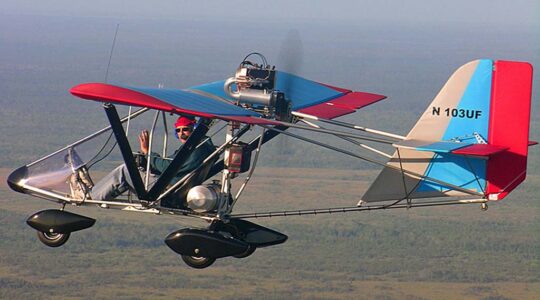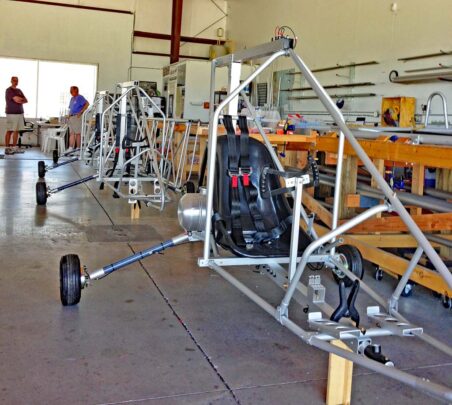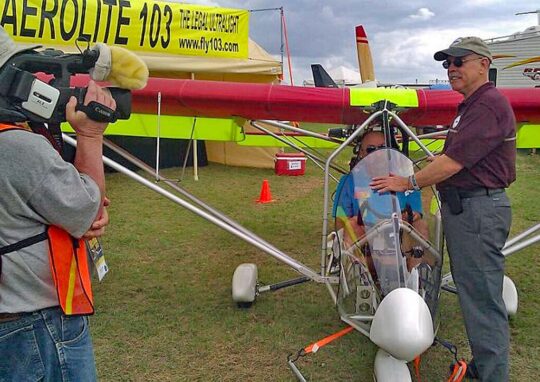Aerolite 103 May Be the Top Seller Among True Ultralights
Among the couple hundred readers who commented on my recent Mosaic article, several referenced private pilots who consider a sport pilot to be “unqualified.” I’ve heard that, too. In fact, I’ve heard similar comments my entire career.
It’s a pecking order thing, I suppose, a natural human response, but I dislike when one aviator puts down another. Is a hang glider pilot somehow less than a power pilot? Is a LSA pilot doing a lesser job flying than a GA pilot? Indeed, is the humble prop pilot somehow less than a jet pilot? Are pilots who like rotary or seaplanes oddballs? I think not, but such opinions are too commonly heard.
Similarly, why are pilots so ill-informed about Part 103? Most pilots have heard of the category, yet most of them know next to nothing about the aircraft type. Contrarily, I can say this: the ones who learn about Aerolite 103 know this is a right-proper light aircraft, and they want more for less.
As a single point, price is important to nearly all consumers. Even in 2023, Aerolite 103 is available for around $25,000. That price comes after three years of high inflation, after the upset of Covid and its effect on supply chains, quadrupled shipping costs, and the outbreak of hostilities in Ukraine. Despite an overload of upsetting, price-increasing actions, Aerolite 103 remains a terrific bargain by almost any measure.
Most of that success at keeping Aerolite 103 affordable is due to just two men.
Dynamic Duo
In the video below, nearly a half million viewers have heard inventor Terry Raber describe his Aerolite 103. Raber built and delivered several hundred of these, it is reported. But many years ago he chose to exit aircraft manufacturing to pursue other interests. He connected with former Challenger build shop operator, Dennis Carley, who has breathed new life into the enterprise.
Carley moved Aerolite to Deland, Florida, and began to set up manufacturing. Prior to Aerolite, he won awards for his craftsmanship. He built more than 100 ultralight and experimental aircraft over a 20 year period, experience that proved valuable when he began manufacturing Aerolite 103.

After moving all of Raber’s inventory and tooling to Florida in January 2013, he reported 20 sales in his first full year of business: a worthy achievement for a re-startup.
Carley’s pace has never stopped. Over the decade he has operated U-Fly-It, the company increased to present capacity of 50–60 Aerolite 103 aircraft per year. I’ve seen him maintain this pace for several years. Over a decade he has likely doubled the fleet that is approaching 1,000 aircraft (based on Raber’s reported “400 or so” during his 15 years of operation, plus steady production by U-Fly-It.)
Raber may have departed from the aviation scene but he did a wonderful job of invention. A former CGS Hawk kit builder and Quicksilver MX assembler, he fused a vision for a simply-constructed aircraft that could stay within Part 103 while offering features other ultralights of the day were not providing.
From the start, Aerolite boasted features others lacked, including:
- A control yoke — most others used joysticks
- Full, conventional three-axis control — common now but wasn’t then
- Electric flaps — few Part 103 ultralight offer flaps, and rarely electric
- Discreet (separate surface) ailerons; not full-span flaperons
- Partial enclosure with a nose cowl and windscreen — open cockpit designs were common
- Tricycle gear — many used standard or taildragger types to save weight
- Hydraulic brakes — brakes were not common on Part 103 ultralights due to the weight constraints of Part 103 plus slow landing speeds
- An aluminum fuel tank, not a plastic one that discolors in time
- Sewn Dacron wing, tail, and surface coverings were common but they save the weight of paint

I love the Aerolite 103. I flew one on several occasions and found it a friendly flying machine with no evil qualities that will fly exactly as you’d expect.
What Aerolite won’t do: You don’t buy an airplane like this to fly long cross country flights. Obviously, you can’t carry passengers. Staying within Part 103 means you are limited to 63 miles per hour and five gallons of gas, good for an hour or two of flying depending on how much up-and-down fun you are having. Some pilots call all these points limitations. Others know the joy such for-fun-only aircraft can deliver.
Aerolite 103 is a full-featured Part 103 ultralight that requires no pilot license of any kind, no N-numbers, and no medical, for less than the average selling price of a new car in the U.S. in 2023. I can attest to its fine flying qualities and long proven design.
Aerolite 103 Price & Value
A complete airframe kit sells for $16,950 including a fully-anodized tube-and-gusset aluminum structure with your choice of sail colors, nose fairing and windscreen, electric flaps, shock-absorbing main gear, steerable nose wheel with suspension, four-point restraint system, 5-gallon aluminum fuel tank, visual fuel quantity gauge, Dacron wing, tail and surface covering that needs no painting, aluminum wheels, tubeless 13 x 5 x 6 Carlisle 4-ply tires, and hydraulic brakes.

Add a fuel engine from Hirth or MZ for 28 to 50 horsepower for a cost of $6,500 to $13,500. You can also choose an electric option that runs from $10-14,000.
A fully-assembled Aerolite 103 runs from $27K–$35K depending primarily on engine selection.

A kit is available with approximately a one-year delay and a fully-built Aerolite 103 will take a bit longer. Like a few other producers I know, Carley has operated U-Fly-It wisely, growing to a workable size but without gambling money on bigger facilities and a larger payroll to build aircraft faster when the market can be unpredictable. U-Fly-It has stable employees that know their tasks well and the business appears to operate with a minimum of friction.
I’ve questioned Carley if he can genuinely run a profitable business at these modest prices. He says yes, and his endurance in the business gives proof to his response.
[embedded content]

